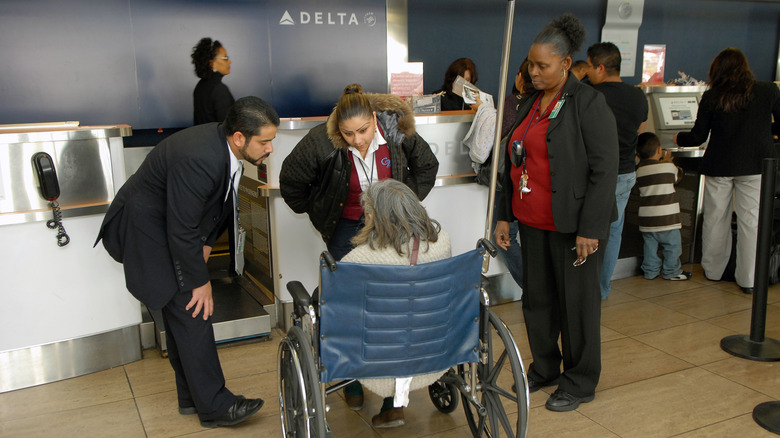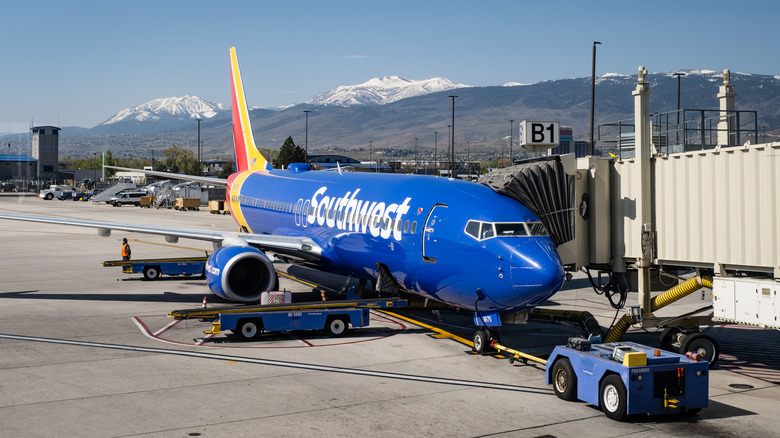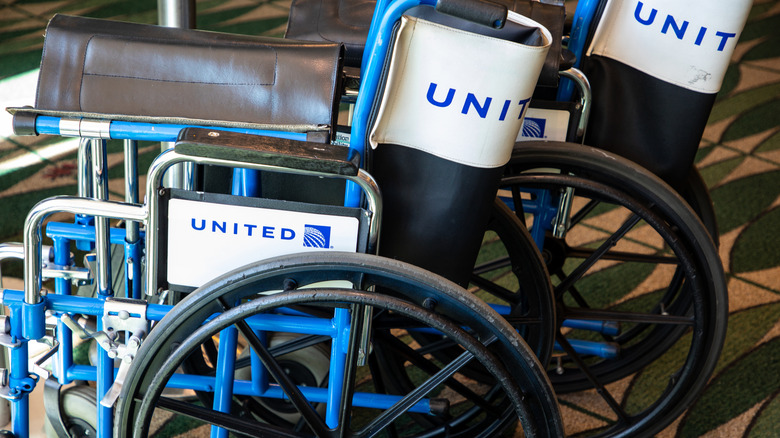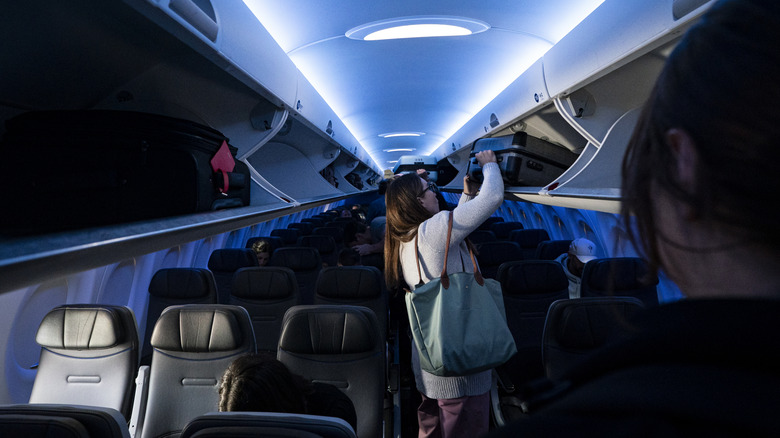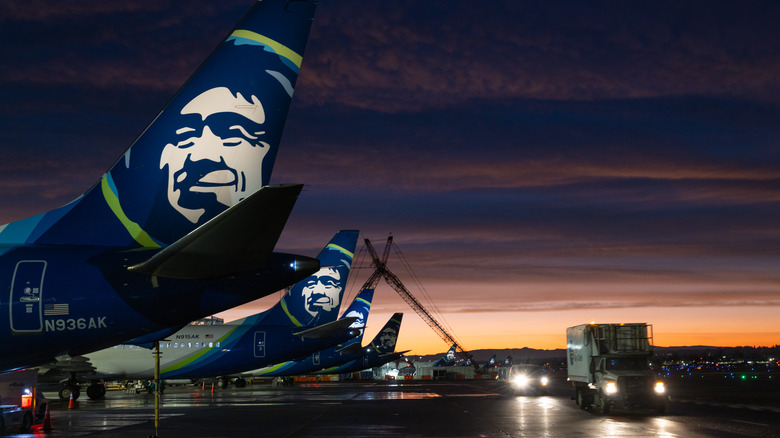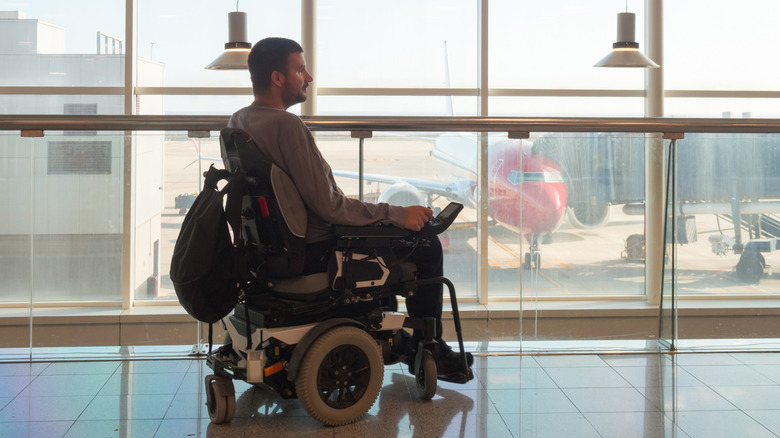The Best US Airlines For Wheelchair Passengers, According To Fliers
Airport environments involve a lot of shuffling around from place to place and moving from one mode of transportation to another, which means that folks in wheelchairs are going to encounter many more difficulties than others. Thankfully, some U.S. airlines stand above the rest for making things as smooth, convenient, and accomodating as possible. After all, an ideal vacation for wheelchair users — or anyone, really — starts with a solid airline experience.
That being said, there's no official, universally agreed-upon list of airlines that are best for wheelchair users. In the U.S., about 2,000 people in wheelchairs or other mobility aids board an airplane every day, and everyone's going to have a different experience, right down to the individual staff members they encounter. There's a lot more to consider, too, like how often an airline mishandles a wheelchair, the quality of their support, or the ease of transferring on and off a plane. Sometimes, there's even complete disagreement between sources, like JetBlue earning the worst possible spot in a 2022 ranking from Wheelchair Travel and the best possible spot in a 2024 ranking from Insure My Trip. The former focused on wheelchair mishandling, while the latter focused on "positive sentiment" among customers. One is also a data-driven measurement, while the other offers personal impressions. Both need to be taken into account when discerning which airlines are best for wheelchair users.
All things considered, though, wheelchair users tend to regard certain airlines as better than others. Delta Air Lines stands at the top of the pile, followed by (in no particular order) United Airlines, Southwest Airlines, JetBlue, and Alaska Airlines.
Delta is the most well-regarded U.S. airline for wheelchair users
Delta stands at the top of the U.S. airline list for wheelchair users. In one Reddit thread, users pointed to Delta being responsible for fewer damaged wheelchairs and receiving the fewest complaints from disabled passengers. According to the U.S. Department of Transportation's Air Travel Consumer Report for the first half of 2025, Delta reported just 0.44% of wheelchairs and scooters damaged during transit. This was out of about 68,500 in total. The same report stated that Delta received 33 disability-related complaints in June 2025.
The writer of the wheelchair-focused travel blog Spin the Globe, meanwhile, says that she's had some good and bad experiences with Delta. The good experiences involved some thoughtful touches, such as wheelchair users being given luggage tags that can be scanned to locate their wheelchair anywhere in an airport. She also mentions being able to call and get an upgrade to a bulkhead seat if possible — and even landing a free upgrade to Delta Comfort.
The travel agents at AranGrant say much the same, ranking Delta Air Lines not just the best for wheelchair users, but for disabled people generally. They also mention the upgrades to bulkhead seats, as well as easy transfers on and off planes, mobility around planes, and assistance getting to the bathroom. They note that Delta's advanced notice period for special accomodations is a bit longer than other airlines at 48 hours, but this is still a reasonably big enough window to make sure that people in wheelchairs get the assistance they need.
Southwest is ranked highly for its boarding procedures
For many wheelchair users, Southwest Airlines used to be their preferred airline. Wheelchair Travel explains that the preference for Southwest boiled down to its boarding policies. For years, the airline offered no assigned seating. Passengers simply showed up at the gates, and seats were issued on a first-come, first-served basis. Because wheelchair users could board first, they could quite literally roll right up to their seats at the front of the plane, no questions asked. On Tiktok, @spintheglobe prasied Southwest for this precise reason, while another user, @bluecopperdesign, demonstrated as much herself.
Southwest's unique status among wheelchair users is coming to a halt, however. Starting January 27, 2026, it will switch to the same kind of assigned seating as every other airline. This comes on the heels of changes made this year to policies concerning lithium-ion batteries, which require powered wheelchair users to extract their wheelchair's battery and carry it with them. No doubt, Southwest's seating policy change will affect its popularity with wheelchair users.
Then again, not all wheelchair users were happy with Southwest to begin with. A handful of critical reviews on TripAdvisor describe Southwest staff behaving negligently towards disabled passengers. These may be outliers, however. Spin the Globe gives Southwest credit for its customer service, placing the airline at the top of the list for wheelchair users.
United rolled out a new booking tool to help wheelchair users
When it came to assisting wheelchair users, United Airlines once sat on the cusp of "bad." One thread, which was posted on TripAdvisor nine years ago, paints United as plagued by garbled policies, highlighting an instance in which staff insisted only disabled passengers with service animals could be placed at the front of an aircraft. Some Redditors have described United staff as disrespectful, or at least poorly trained when it comes to passengers in wheelchairs. Other reviews from TripAdvisor similarly point the finger at incompetent or even hostile staff, and one Facebook post depicts an exhausting, automated customer support exchange that went nowhere, adding: "United could care less about its consumers."
At the same time, Wheelchair Travel placed United within the top three airlines for wheelchair users in 2022, taking into account metrics such as complaints, delays, and mishandled wheelchairs. According to the DOT's Air Travel Consumer Report for the first half of 2025, United had fewer mishandled wheelchairs than the more highly-regarded Southwest, at 1.02% versus 1.22%. Some reviews from TripAdvisor also lavish United with praise, using five-star review titles like, "Best wheelchair assist ever." Travel site AranGrant also rates United as the third-best U.S. airline for wheelchair users, citing plane accessibility and seating options, plus ease of website use.
These last points indicate that United, on a whole, is working hard to do its best for wheelchair users and will continue to improve over time. In 2024, United became the first U.S. airline to offer a wheelchair sizing tool to ensure that wheelchair users get paired with the right aircraft. Within months, 20,000 people had used the tool, and United saw a four-point boost in customer satisfaction from the year prior.
JetBlue has the best reported positive sentiment
JetBlue earns a spot on our list largely because of the 97% "positive sentiment" rating it scored from Insure My Trip. This is despite JetBlue having the highest percentage of mishandled or damaged wheelchairs on the DOT's 2025 Air Travel Consumer Report, at 1.56% of 14,000 wheelchairs. Despite this number, the same report says that JetBlue only received nine complaints from disabled individuals in June 2025. Perhaps thanks to the airline's unexpectedly high-quality entertainment options, legroom, snacks, or overall comfort, it seems like wheelchair users generally think well of JetBlue. And indeed, Spin the Globe mentions two reasons why it makes their personal list of the top three U.S. airlines for people in wheelchairs: the entertainment and a lack of any real issues to speak of.
On TripAdvisor, some reviews are predictably scathing, while others seem to adore JetBlue. Certain positive reviews point to specific JetBlue staff members by name for making their flights pleasant and easy, with one review claiming that the captain himself helped them out. Another reviewer talks about her 70-year-old mother having an easy time because of JetBlue's helpful wheelchair service. One brisk review simply says that everything was good and the staff were nice, while another tellingly distinguishes between the airport experience at JFK, which was bad, and the JetBlue airline experience once they got to the gate — which was a lot better.
Alaska Airlines is a solid choice for wheelchair users
We round out our list with Alaska Airlines, a solid overall choice for wheelchair users. Insure My Trip's report placed Alaska Airlines at third place in the U.S., right above Hawaiian Airlines. Interestingly, Alaska Airlines bought Hawaiian Airlines in 2024, after having bought Virgin America in 2016. But Alaska Airlines and Hawaiian Airlines still operate separately, and Alaska wins out between them. Notably, Insure My Trip points out that the airline has the second-lowest number of 1-star ratings from wheelchair users, at 9%. This is true even though the DOT's Air Travel Consumer Report reports that Alaska Airlines had the third-highest number of instances of wheelchair mishandling and damage, at 1.4% of almost 19,000 wheelchairs.
Some sites, like TrustPilot, rank Alaska Airlines very poorly generally, but they don't have a high sample of wheelchair users. TripAdvisor, meanwhile, gives the airline a 4.0 out of 5.0 overall rating with nearly 18,000 reviews and a substantial sample of wheelchair users. Multiple 5-star and 4-star reviews mention the ease of getting through the airport with Alaska Airlines, which is always a big concern for those in wheelchairs. One reviewer mentions not being able to personally push his 91-year-old mother to the gate because of airline policies, but still praises a specific staff member for trying to make it happen. All in all, and barring exceptions, Alaska Airlines offers a solid experience for wheelchair users.
Methodology
To write this article, we gathered information from a variety of sources that included first-hand testimonials from wheelchair users. These were taken from TripAdvisor, Reddit, Facebook, TikTok, and Spin the Globe. We also drew on experiences aggregated by the wheelchair-focused site Wheelchair Travel, as well as the travel site Insure My Trip. The latter two sources also referenced data from the U.S. Department of Transportation, which itself is compiled from user experiences. Overall, the article incorporates feedback from tens of thousands of individuals, but, in the interest of fairness, also includes edge cases that run counter to overall trends among wheelchair users.

